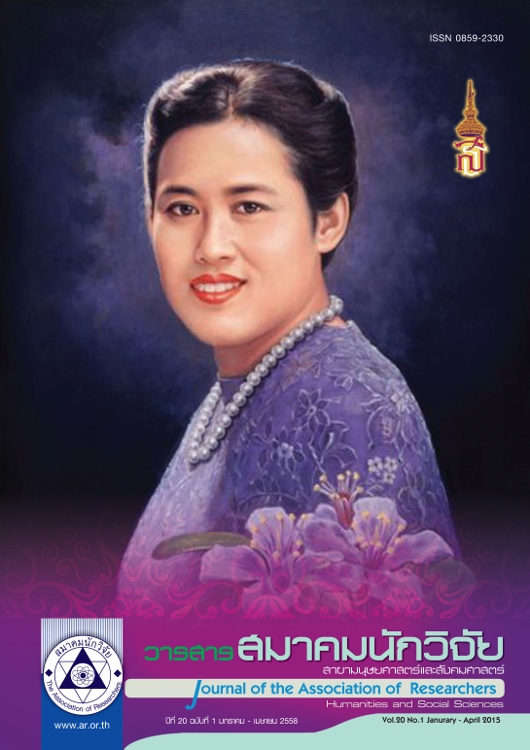Components Related to the Effectiveness of Lifelong Learning Facilitation of Non-Formal Education and Educational Preference at the District Level in Accordance with Teachers Perception
Main Article Content
Abstract
The objectives of this research paper were to analyze influences of components related to the effectiveness of lifelong learning facilitation of non-formal education and Educational preference at the district level in accordance with teachers perception. The sample group of 807 staff working for non-formal and informal education centers was chosen by multi-stage sampling. The data was collected by using the questionnaire with the reliability or alpha coefficient of 0.99 and then analyzed in terms of descriptive and inferential statistics by Statistical Package for Social Science and the Structural Equation Model analyzed program. The research results were summarized as follows:
1. The result of the goodness of fit test between the model and the empirical data analyzed by using Relative Chi-square, Goodness of Fit Index (GFI), Comparative Fit Index (CFI), and Root Mean Square Error of Approximation (RMSEA) showed that the model was well fitted with the empirical data.
2. The components directly influencing the effectiveness of lifelong learning facilitation of the district non-formal and informal education centers ranked based on the level of coefficient from most to least were teacher behavior, learner characteristics, and administrator behavior, respectively. The components indirectly influencing the effectiveness were organization competency, administrator
behavior, and teacher behavior, respectively.
Article Details
บทความที่ปรากฏในวารสารนี้ เป็นความรับผิดชอบของผู้เขียน ซึ่งสมาคมนักวิจัยไม่จำเป็นต้องเห็นด้วยเสมอไป การนำเสนอผลงานวิจัยและบทความในวารสารนี้ไปเผยแพร่สามารถกระทำได้ โดยระบุแหล่งอ้างอิงจาก "วารสารสมาคมนักวิจัย"
References
นิศานาศ นนท์จุมจัง. (2553). การศึกษาภาวะผู้นำแบบเปลี่ยนสภาพของผู้บริหารโรงเรียนและประสิทธิผล ของโรงเรียน สังกัดสำนักงานเขตพื้นที่การศึกษาสระแก้ว. วารสารการบริหารการศึกษา, 4,2 (เมษายน-กันยายน), 87-99.
พสุ เดชะรินทร์. (2555). พัฒนาองค์กรให้มีขีดสมรรถนะสูง. สืบค้นเมื่อ 29 กรกฎาคม 2555. จาก http://www.opdc. go.th/oldweb/thai/E_Newsletter/oct_2006/e-newsletter/ High%20 Performance.htm
พาสกร อินทร์เทพ. (2555). อิทธิพลของภาวะผู้นำการเปลี่ยนแปลงผ่านตัวแปรเกี่ยวกับงานที่มีผลต่อการปฏิบัติงานของ ครูโรงเรียนพระปริยัติธรรมแผนกสามัญศึกษาในประเทศไทย. วารสารวิจัยและพัฒนา, 4(4), 67-75.
พิสณุ ฟองศรี. (2550). วิจัยชั้นเรียน: หลักการและเทคนิคปฏิบัติ (พิมพ์ครั้งที่ 5). กรุงเทพฯ: พรอพเพอตี้พริ้นต์.
ภารดี อนันต์นาวี. (2549). การวิเคราะห์ภาวะผู้นำของผู้อำนวยการเขตพื้นที่การศึกษาและบรรยากาศองค์การที่ส่งผล ต่อการบริหารจัดการที่ดีของสำนักงานเขตพื้นที่การศึกษา ภาคตะวันออก. วารสารศึกษาศาสตร์, 18,1(มิถุนายนตุลาคม), 89-102.
วิมลรัตน์ บุญชู. (2549). องค์ประกอบที่สัมพันธ์เชิงสาเหตุกับประสิทธฺผลการจัดการศึกษาขั้นพื้นฐานของสถานศึกษาเอกชน สังกัดสำนักงานคณะกรรมการการศึกษาขั้นพื้นฐาน (วิทยานิพนธ์ปริญญาดุษฎีบัณฑิต, มหาวิทยาลัยบูรพา).
สนอง สุภาสัย. (2545). การใช้ภาวะผู้นำที่มีคุณภาพของผู้บริหารโรงเรียนที่ครูมีความพึงพอใจแตกต่างกัน: กรณีศึกษา จังหวัดสมุทรสาคร (วิทยานิพนธ์ปริญญามหาบัณฑิต, มหาวิทยาลัยศิลปากร).
สมชาย พุทธโกสัย, สุทธนู ศรีไสย์, และจินต์ วิภาตะกลัศ. (2556). คุณภาพการบริหารจัดการสถานศึกษาระดับประถม ศึกษาในเขตตรวจราชการที่ 2 กระทรวงศึกษาธิการ. วารสารสมาคมนักวิจัย, 18,2(พฤษภาคม-สิงหาคม), 84-98.
สุชาติ เอกปัชชา, สุทธนู ศรีไสย์, และจินต์ วิภาตะกลัศ. (2557). ประสิทธิผลการบริหารจัดการโรงเรียนดีประจำตำบล ในประเทศไทย. วารสารสมาคมนักวิจัย, 19,1(มกราคม-เมษายน), 47-58.
สุภัทรา วีระวุฒิ. (2554, กันยายน-ธันวาคม). ปัจจัยที่มีอิทธิพลต่อประสิทธิผลของโรงเรียนประถมศึกษา สังกัดสำนักงาน คณะกรรมการการศึกษาขั้นพื้นฐานในจังหวัดนนทบุรี. วารสารการบริหารและพัฒนา, 3(3), 111-126.
Baskett, S., & Miklos, E. (1992). Perspectives of effective principals. The Canadian Administrator, 32(1), 1-10.
Bagozzi, R.P., Yi, Y., & Phillips. L.W. (1991). Assessing construct validity in organizational research. Administrative Science Quarterly, 36(3), 421-458.
Creemers, B. (1994). The Effective Classroom. London: Cassell. Cropley, A.J. (1977). Lifelong Education: A Psychological Analysis. Hamburg: UNESCO Institute for Education.
Deegan, Jr.J. (1978). On the occurrence of standardized regression coefficients greater than one. Educational and Psychological Measurement, 38, 373-888.
Diamantopoulos, A., & Siguaw, J.A. (2000). Introducing LISREL: A Guide for the Uninitiated. London: SAGE Publications.
Farrell, A.M. (2010). Insufficient discriminant validity: a comment on Bove, Pervan, Beatty, and Shiu (2009). Journal of Business Research, 63(3), 324-327.
Fornell, C., & Larcker, D.F. (1981, February). Evaluating structural equation models with unobservable variables and measurement error. Journal of Marketing Research, 10(1), 39-50.
Good, C.V. (1973). Dictionary of Education. New York: McGraw-Hill.
Hair, J.F. Jr., Anderson, R.E., Tatham, R.L. & Black, W.C. (1995). Multivariate Data Analysis with Reading (4thEd). New York: Prentice Hall.
Hall, G., Rutherford, W.L., Hord, S.M., & Huling, L.L. (1984). Effects of three principal styles on school improvement. Educational Leadership, 41(2), 22-26.
Hilderbrand, M.E., & Grindle, M.S. (1994). Building Sustainable Capacity: Challenges for the Public Sector. Retrieved December 15, 2013, from http://mirror.undp.org/magnet/cdrb/parti.htm
Hoy, W.K., & Miskel, C.G. (2001). Educational Administration: Theory Research and Practice (6thEd). New York: McGraw-Hill.
Kline, R.B. (2005). Principles and Practice of Structural Equation Modeling (2ndEd). New York: The Guilford Press.
Medal-Añonuevo, Carolyn. (2001). Revisiting Lifelong Learning for the 21st Century. Humburg: UNESCO Institute for Education.
Mitchell, M., & Jolley, J. (2004). Research Design Explained (5thEd). Toronto: Wadsworth.
O'Regan, N., & Ghobadian, A. (2004). The importance of capabilities for strategic direction and performance.
Management Decision, 42(2), 292-312. Preedy, M. (1993). Managing the Effective School. London: Paul Chapman.
Steers, R.M., & Black, J.S. (1985). Organizational Behavior. New Jersey: Prentice Hall. Tasmin, R., & Wood, P. (2008). Knowledge management and innovation in Peninsular Malaysia. pp. 158-164. In Transferring, Managing and Maintaining Knowledge for Nation Capacity Development. Proceedings on Knowledge Management International Conference 2008
(KMICE 2008). Universiti Utara Malaysia, Sintok.


